
About UsThe Numismatic Bibliomania Society is a non-profit organization devoted to the study and enjoyment of numismatic literature. For more information please see our web site at coinbooks.org SubscriptionsThose wishing to become new E-Sylum subscribers (or wishing to Unsubscribe) can go to the following web page link MembershipThere is a membership application available on the web site Membership Application To join, print the application and return it with your check to the address printed on the application. Membership is only $20 to addresses in the U.S., $25 for First Class mail, and $30 elsewhere. For those without web access, write to: David M. Sundman, Treasurer
AsylumFor Asylum mailing address changes and other membership questions, contact David at this email address: dsundman@LittletonCoin.com SubmissionsTo submit items for publication in The E-Sylum, just Reply to this message, or write to the Editor at this address: whomren@gmail.com BUY THE BOOK BEFORE THE COIN |
- WAYNE'S WORDS: THE E-SYLUM MARCH 29, 2015
- KOLBE & FANNING EXPAND ONLINE RETAIL OFFERINGS
- NEW BOOK: PIERCED COINS
- NEW BLOG: POCKET CHANGE
- NUMISMATIC ODDBALLS
- HANS ERNI (1909-2015)
- 'COINS LOOTED BY ISIS' STORY DISPUTED
- NOTES FROM E-SYLUM READERS: MARCH 29, 2015
- QUERY: CHARLES L. STAKE
- QUERY: IS IT REALLY MONTROVILLE DICKESON IN THIS PHOTO?
- EARL & KOEHLER COIN BOARDS BRING RECORD PRICE
- LESHER REFERENDUM DOLLARS
- RECYCLERS DEFRAUD U.S. MINT WITH CHINESE COUNTERFEIT COINS
- A SHORT HISTORY OF THE FRANKLIN MINT
- ARTICLE PROFILES D. BRENT POGUE
- THE BUSHNELL-PARMELEE BIRCH CENT BRINGS $1.2M
- REPORTER INTERVIEWS KRALJEVICH ON COIN RARITIES
- HISTORY OF THE NATIONAL NUMISMATIC COLLECTION
- HOWARD BERLIN VISITS RIGA, LATVIA
- QUERY: MANKATO DAKOTA INDIANS HANGING ITEMS SOUGHT
- ALASKA CENTENNIAL MOOSE GOOSER MEDALS
- NYPD CHALLENGE COIN FEATURES SHERLOCK HOLMES
- ORDER OF THE BATH MEDAL
- ARTICLE PROFILES ERROR COIN DEALER FRED WEINBERG
- TEENAGE TRIUMPHS OF Q. DAVID BOWERS
- NEW YORK COPPER COINS IN THE KENDALL COLLECTION
- BELL CANADIAN TOKEN COLLECTION OFFERED
- COINS MAY BE FROM A "ROMAN MCDONALD'S"
- SPINK SELLING EBORACUM HOARD COINS
- THE MOHAWK VALLEY HOARD COINS
- WOMAN TURNS BANK BUILDING INTO HER HOME
- EARLY BANK ROBBERIES IN VIRGINIA
- BRITISH COMPANY GIVES AWAY FOLDED BANKNOTES
- COINS FOUND IN POSSIBLE ARGENTINA NAZI HIDEOUT
- A WEST COAST NUMISMATIC LIBRARY
Click here to access the complete archive
To comment or submit articles, reply to whomren@gmail.com
WAYNE'S WORDS: THE E-SYLUM MARCH 29, 2015

New subscribers this week include: Mitch Battino, courtesy of George Cuhaj; Chris McCawley, Patrick Ian Perez, and Stu Shaw. Welcome aboard! We now have 1,840 subscribers.
This week we open with a note from literature dealers Kolbe & Fanning, a new book, a new blog, and reaction to the "numismatic oddballs" reference.
Other topics include coin dealer Charles Stake, collector D. Brent Pogue, dealer Fred Weinberg, author Montroville Dickeson, Lesher Referendum Dollars, the Franklin Mint, and the Order of the Bath medal.
To learn more about General Numismatics Corporation (GNC), pierced coins, medallist Hans Erni, Earl & Koehler coin boards, Moose Gooser medals, the National Bank of Latvia, and the Mohawk Valley hoard, read on. Have a great week, everyone!
Wayne Homren
Editor, The E-Sylum
KOLBE & FANNING EXPAND ONLINE RETAIL OFFERINGS
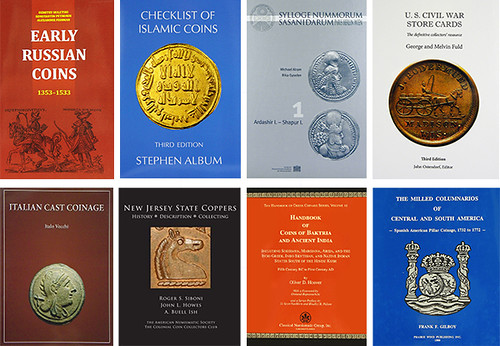
Kolbe & Fanning have been augmenting their online bookstore, substantially expanding offerings of numismatic books for direct retail sale at fixed prices. Their online bookstore, on the main Kolbe & Fanning website at www.numislit.com, currently includes over 1350 titles spanning the entire world of numismatics. While many numismatists associate Kolbe & Fanning strictly with auctions, our direct retail sales have been a growing part of our business, and it is an area we intend to develop more fully.
The numislit.com site is easy to use, and is designed both for browsing and for more focused searches. Customers can use the Search box to look for specific subjects or titles, can check out recent additions to the inventory, or browse entire categories of books by simply clicking on the relevant link. Categories include:
- Ancient Greek
- Ancient Roman
- Celtic
- Ancient (Other)
- Asian
- Islamic
- Jewish
- Medieval
- Byzantine
- Russian
- Modern Foreign
- Latin-American
- United States
- Medals
- Paper Currency
- Periodicals
- Sale Catalogues
- Bibliography
- Antiquarian Titles
- General References
- Specials
- Discounted Titles
Titles offered include new publications, as well as the rare and out-of-print classics in which we specialize. Each title is illustrated and fully described. Customers may place orders through our secure server; creating an account is optional, but useful for customers who may place additional orders from time to time. PayPal and all major credit cards are accepted; one may also pay by check or money order.
We are currently planning a full website redesign that we will announce shortly; it will make the site much easier to use on handheld devices. Our intention is to offer a wide range of material appealing to various tastes. Prices range from $10 to $4000. Kolbe & Fanning are excited about developing this part of our business and invite you to check us out at www.numislit.com.
NEW BOOK: PIERCED COINS
Contains chapters on :
- Who drilled a hole in a good coin and why? We name the guilty men.
- Different types of piercing and how to catalogue them.
- What to say to someone who drills a hole through a valuable coin.
- Religious pierced coins – Holier than thou...
- Counterfeit and forged holes – not real holes but white dots painted on to look holed.
At long last this area of numismatics has been nailed! This splendid new work is an ideal addition to the collector’s bookshelf. It is truly a deeply boring book. It features recent research from hoard evidence and builds on earlier reference texts such as:
- In German - Der yahrbuck Muntzenmitdieholesindem
- In French - l’Amour et la Monnaie avec une ole
- In Spanish - Hole! Las Monedas Espani- holeas
The book was meant to have a hole for string to be attached in the top corner but unfortunately the publisher made the hole right in centre.
THE BOOK BAZARRE
NEW BLOG: POCKET CHANGE

The American Numismatic Society has launched a new blog, Pocket Change, to expand the organization’s digital presence and provide a forum for the public to learn more about the Society’s collection. To find it, please direct your browsers to this address: www.anspocketchange.org .
Pocket Change will feature contributions from the curatorial staff about their ongoing research, news and notes about visiting scholars, and regular posts on noteworthy objects and recent acquisitions. The blog will also give a periodic look to work behind the scenes at the ANS and everything that goes into caring for and managing our ever-expanding collection of coins and currency. We will also be highlighting new digital publications and online content from the library and archives as they become available. The overall focus will be on giving both members and the public a window into proceedings here, and to provide a digital forum for our educational efforts in the field of numismatics more generally.
Pocket Change will also allow us to feature content that is best suited to digital media. To that end, we are inaugurating a new monthly video series, which begins with a short film about the Fairbanks’ Infallible Coin Scale. The first major digital project will be an ambitious examination of the numismatic dimensions of the Lewis and Clark Expedition using Historical GIS (a fancy term that essentially means plotting data onto digital historical maps). Beginning in May, there will be an ongoing series of blog posts that trace the route of the two-year expedition, and center on where and to whom the Indian Peace Medals that the company carried with them were distributed. The project promises to shed some new light on the role that the medals played in the context of the Lewis and Clark Expedition, and also to demonstrate how numismatists might begin to employ a range of new digital tools to their work.
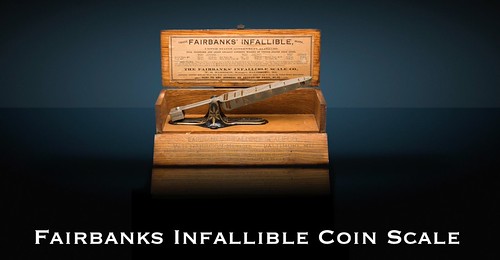
One of the great appeals of a blog such as this is its flexibility. Exactly how Pocket Change develops will in part depend on its audience, and to that end we will feature a lot of interactive content. We have introduced a regular “Ask a Curator” column where we will answer reader questions about the ANS collection. A “Mysteries of the Vault” series highlights objects in the collection that we hope our knowledgeable readership can help us identify and learn more about. If you have ideas or questions about things you would like to see addressed on Pocket Change, please just use the “Contact” page on the website to let us know!
- ASK A CURATOR: What is the oldest coin in the ANS collection?
- LESHER REFERENDUM DOLLARS
- PROFILES IN RESEARCH: Hilary Becker
- WOMEN ON TWENTIES
- INTRODUCING THE ANS
- CUTTING DOWN OLD HICKORY
- ASK A CURATOR: What is the heaviest coin in the collection?
- MYSTERIES FROM THE VAULT
- NUMISMATIC FOLK ART
- FAIRBANKS INFALLIBLE COIN SCALE
NUMISMATIC ODDBALLS
Regarding the review of Kabir Sehgal's book Coined. A reader writes:
I was disheartened that the New York Times reviewer spoke about coin collectors in the manner in which she did. I prefer articles that educate folks about the importance of coin collectors and the role they play in preserving our national history.
Joel Orosz writes:
 I bestirred myself to add Kabir Sehgal's Coined to my library, and one of the
first things I checked was the identity of the "oddball" numismatists (to use reviewer Jessica Pressler's term),
interviewed by the author in Chapter 8, Gilt Complex.
I bestirred myself to add Kabir Sehgal's Coined to my library, and one of the
first things I checked was the identity of the "oddball" numismatists (to use reviewer Jessica Pressler's term),
interviewed by the author in Chapter 8, Gilt Complex.
A number are interviewed, and more are quoted. Two of the interviewees stand out as NBS and E-Sylum stalwarts, namely Howard Daniel and Harvey Stack.
Howard is identified by Sehgal as "the Satan of numismatics" for his brutal honesty, and Harvey is identified as the Dean of coin dealers for his seniority in the field.
Among those quoted is another E-Sylum standby, D. Wayne (Dick) Johnson.
If these are the kind of people Ms. Pressler considers "oddballs," I'm happy to be counted among them!
To read the earlier E-Sylum article, see:
BOOK REVIEW: COINED (www.coinbooks.org/esylum_v18n12a07.html)
HANS ERNI (1909-2015)
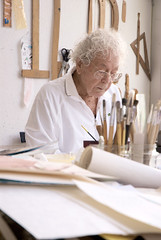 One month after his 106th birthday Swiss artist and medallist Hans Erni died
on 21 March 2015. He bequeaths a rich artistic oeuvre comprising drafts of a banknote series never issued, a commemorative coin, medals,
and stamps.
One month after his 106th birthday Swiss artist and medallist Hans Erni died
on 21 March 2015. He bequeaths a rich artistic oeuvre comprising drafts of a banknote series never issued, a commemorative coin, medals,
and stamps.
Hans Erni was born on 21 February 1909. He was son to the operator of the steamboat running on the Lake Lucerne and one of his seven children. At the age of only 18 Hans Erni took up art studies in Lucerne and travelled to Paris one year later where he quickly socialised with the international artists’ scene. Erni had close contact with so great artists as Picasso and Braque. He helped them in exhibiting their works in the Lucerne art museum.
At that time such urbanity was suspicious in Switzerland. When a new banknote series designed by Erni and another artist was to be issued in 1938 it was, instead, pulped at the instigation of a Lucerne parliamentarian. In the late 1930s it was truly inconceivable for a bourgeois that ‘of all things a communist like Erni’ should have obtained such a contract. Yet in 1950 the Federal Council officially declared that Hans Erni would never again get a public contract.
Actually Hans Erni never joined a political party although one may call his works political without any doubt. His oeuvre reflects an engaged man who always said what he thought right. It did not matter to him whether he created election posters for the introduction of the women’s suffrage or the Swiss pension scheme AHV, or stamps, coins, or medals.

Hans Erni Four Elements medal: Fire
Since 1969 Hans Erni has created some 25 medals in gold, silver and bronze.
You can read more about Hans Erni and his medallic work on the Erniland website.
To read the complete article, see:
Hans Erni (1909-2015) (http://coinsweekly.com/en/News/4?&id=3331)
To visit the Ermiland web site, see:
http://www.erniland.com/ErniMedals/index.asp

'COINS LOOTED BY ISIS' STORY DISPUTED
Blogger Paul Barford had a great post about this story back on that day, but I didn't see it until now. Here's an excerpt. -Editor
" There is a lot of irresponsible journalism going around these days connected with alarmist stories on ISIL."
"What strikes me is that right under the heading is a picture of an eBay auction "Ancient coin", and the caption reads apparently unambiguously: "Stolen coins are among the plundered artefacts going on the open market". After a bit of a search, one may follow the clues back to the dealer whose auction has been highlighted."
"If I were a dealer whose name figured in such a context, I'd probably be having a word with my lawyer tomorrow. Both newspapers have enough money to make a lawsuit with them worthwhile. A doddle - on condition that the dealer can come up with documentation that will stand up in court as proof that the claim is false. Can he? We will see what their next move is. This is an ACCG dealer..."
To read the complete article, see:
Landmark Coiney Libel Case Coming up?
(http://paul-barford.blogspot.co.uk/2015/03/landmark-coiney-libel-case-coming-up.html)
"Despite the headline, the Times has not presented any evidence of Islamic State-looted antiquities on eBay."
"Unfortunate sub-editing is always a risk. Hugh Tomlinson has suffered it before, but this time it’s worse – especially because the prominence of his article’s recyclers has spread the headline far and wide. Tomlinson is sensible and blunt about sensationalist statements that concern the Islamic State, so I’m confident that he was (literally) thousands of miles away from the Times’ headline. He was kind enough to discuss the article the morning after it was published, so I know a bit about its background, but the rest is my comment.
"It was written as a review of the problem of antiquities trafficking and illicit sale, which has been worsened by the rise of the Islamic State. However, it repeatedly explained the functioning of the trade by reviewing how “the Islamists”, “the jihadists”, “Isis” did things. It did not explicitly identify any non-jihadist paramilitary looters and traffickers."
"Myriads of objects of ‘murky’ legality are available via eBay and other online auctioneers and traders. It is inevitable that some antiquities looted, trafficked, taxed or otherwise racketeered by the Islamic State – as well as by other jihadist militias, the Free Syrian Army, other rebel factions, the Assad regime, even foreign forces – will turn up on eBay."
"When Morag Kersel saw the Daily Mail’s churned version of the Times’ original story, she wondered ‘how the author [had made] the link between ISIS, eBay and these particular coins’. That may have been because the Mail’s author, Jack Crone, did not copy-and-paste Erin Thompson’s cautious observation to Hugh Tomlinson that it was ‘extremely difficult to tell if individual items were looted recently, [were looted] long ago or come from a legitimate source’."
"The Times illustrated its piece with an image that was captioned, ‘Stolen coins are among the plundered artefacts going on the open market’. It was not a stock image of a coin. It was an image of a specific coin that was on the open market – a coin from Apamea on eBay, which was on offer at a reduced price (down from $106.40 to $85.12)."
"While readers might see “small coins such as these” as an illustration of a kind of object and its ease of transport, it is very difficult to see “historical artefacts believed to have been looted by ISIS, such as this coin” as anything other than a statement that this coin is believed to have been looted by ISIS."
"I’m not alone in thinking that these reports could leave the publishers at risk of a libel claim, as long as ‘the dealer can come up with documentation that will stand up in court as proof that the claim is false’. Is that the only way that publishers will be convinced to ensure more responsible reporting?"
To read the complete articles, see:
Conflict antiquities from
Apamea do not finance the Islamic State – they finance the Assad regime
(https://conflictantiquities.wordpress.com/2015/03/18/syria-apamea-ebay-islamic-state-assad-regime/)
Islamic State-looted antiquities on
eBay? ‘The stories are absolutely false and defamatory.’ Multiple libel actions will follow.
(https://conflictantiquities.wordpress.com/2015/03/19/syria-apamea-ebay-islamic-state-libel/)
NOTES FROM E-SYLUM READERS: MARCH 29, 2015
Marketing Pre-1960 Nickels
Tom DeLorey writes:
Back when I was working for Harlan Berk in Chicago, we had one itinerant coin dealer who used to drop by two or three times a year and buy stuff that he supplied to telemarketers. There were certain things he always needed, and as I broke down collections and/or sets I would save the things he wanted in large plastic bags. When he did come in we would run the contents of each bag through the coin counter and write up an invoice. He paid 8 cents each for pre-1960 nickels. I have no idea who he sold them to.
To read the earlier E-Sylum article, see:
NOTES FROM E-SYLUM READERS: MARCH 22, 2015 : Pre-1960 Nickels
(www.coinbooks.org/esylum_v18n12a11.html)
The 'Rare 1943-Dated Lincoln Cent'
Dave Lange writes:
We've seen many times how the non-numismatic press can bungle coin-related stories, and I've found another one in the latest issue of American History.
In reporting the sale of the finest known Birch Set from the Partrick Collection the writer made the predictable mistake of calling this coin a "penny," as well as the less expected one of describing buyer Kevin Lipton as a "collector." The most worrisome error, however, is found in the revelation of the previous record-price holder in the cent category.
It's noted that $1.7 million had been paid a few years earlier for a "rare 1943-dated Lincoln cent." The omission of the fact that this coin was extremely rare by virtue of being the only known 1943-D bronze cent will send hundreds, if not thousands of readers to their phones. I'm alerting every coin shop owner, in fact every coin dealer, that they may be bombarded by excited questions from persons having one or more rusty steel cents...
The New Deluxe Redbook
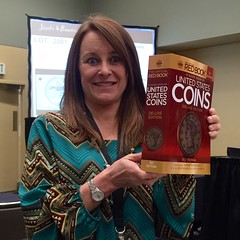 Dave Sundman writes:
Dave Sundman writes:
Here's a photo of Mary Burleson holding the new 6.5 pound edition of the New Deluxe Edition of the Redbook.
To read the earlier E-Sylum article, see:
NEW BOOK: 2016 DELUXE EDITION RED BOOK
(www.coinbooks.org/esylum_v18n09a03.html)
'Coins of the British World' Cover Image Sought
Dave Lange writes:
I'm seeking a good (300 dpi) scan of the dust jacket from Robert Friedberg's book Coins of the British World (1962) that I can include in my book on coin albums of The Coin & Currency Institute. Though I have this book in my library, it lacks the colorful dust jacket, and my efforts to acquire a copy including this have been unsuccessful.
Query: Professor Johnson’s Token
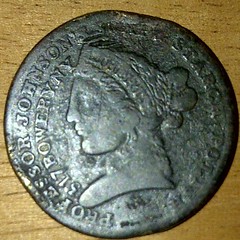
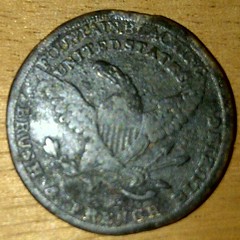
David Pickup writes:
Here are photos of a token I bought this week. It is inscribed Professor Johnson’s ...... Starch Polish / 317 Bowery NY / Fountain Blacking / Brush French Bluing / United States
Any more information on it or value?
Laura Ingalls Wilder Medal Design
John Sallay passed along this item:
2015 April 8 Rare Books Signature Auction - New York by Heritage Auctions Platinum House April 8, 2015, 11:00 AM EST New York, NY
Lot 45452: Garth Williams (American 1912-1996).
 Estimated Price: $800 - $1,200
Estimated Price: $800 - $1,200
Description: Garth Williams (American 1912-1996). Original Drawing for the Laura Ingalls Wilder Award. [N.p., n.d., ca. 1960]. Original
circular drawing featuring Laura Ingalls Wilder as a child, holding a doll, fashioned from three layers of paper, measuring 10 inches in
diameter. Pencil on paper. Signed "Garth" on the front, and with Mr. Williams' full signature on the reverse with
instructions to return the drawing to him in Aspen, Colorado. Drawing has a few shallow bends, a tiny nick to the edge (above the
"G" in "Ingalls"), and a glue stain along the top of Laura's head. Else, in generally near fine condition. The
Wilder Award is a bronze medal awarded to an author or artist by the Association for Library Service to Children, a division of the
American Library Association, for excellence in children's literature.
QUERY: CHARLES L. STAKE
Dave Hirt was at the Whitman Baltimore show on Thursday. He writes:
I wasn't really expecting to buy more books, but OF COURSE I DID. Charlie Davis had such good prices on books in new condition that I bought four of them. Then, on the way out, on the free table a man was empting two large boxes of auction catalogs. I picked up four of them (my wife Emi was not very happy).
I would like to ask the readers for information about one other item I bought. It is a fixed price list of Charles L. Stake dated 1879. His address was 24 Maple Street, Dayton, Ohio. He lists a rather complete listing of US, copper & Nickel coins for sale. He also states he will bid for anyone at US auction sales foe 10%, and has priced catalogs for sale.
Gengerke lists 12 auction sales for him, but they are rarely, if ever offered. I have been collecting auction catalogs for 50 years, and do not own one. Do any of our readers know anything about Stake?

QUERY: IS IT REALLY MONTROVILLE DICKESON IN THIS PHOTO?
 In your Volume 15, Number 30, July 15, 2012 entry MORE ON MONTROVILLE DICKESON there is a photograph purportedly of Mr. Dickeson standing
with a Native American chief.
In your Volume 15, Number 30, July 15, 2012 entry MORE ON MONTROVILLE DICKESON there is a photograph purportedly of Mr. Dickeson standing
with a Native American chief.
Steven Frank recently posted this photo to the ContemporaryCounterfeitWorldCoins Yahoo.com discussion group - unidentified - as something of a quiz to see who could identify the subject.
At the time he posted the photo I had no knowledge of Montroville Dickeson and I sought to identify the photo using internet research. Through a combination of fortunate key words and the magic of Google Images I found a photo that looked to be the same subject but in this photo he was seated next to a different Native chief.
That photo is part of a collection of Nez Perce Chiefs on a Pinterest site. Using that site I was able to identify the two subjects as Chief Tamason or Timothy, Nez Perce and Perrin Whitman, interpreter.
When I forwarded my guess to Steve he indicated that there must be some mistake with my source since his photo had been identified as Montroville Dickeson.
We soon came to the conclusion however, based on locating a clearer photo at the Smithsonian Institution here: http://siris-archives.si.edu/ipac20/ipac.jsp?uri=full=3100001~!13320!0
... and another photo which is attached to Perrin Whitman's findagrave.com entry here: http://www.findagrave.com/cgi-bin/fg.cgi?page=gr&GRid=124371993
... that the photo in question very possibly is of Perrin Whitman and not Montroville Dickeson.
Here is a composite Steve put together with the known portrait of Montroville Dickeson on the left. The newspaper article is something I found which mentions a photograph of Perrin Whitman and it is from 1936. I am writing for more opinions and comments from E-Sylum readers.

Julia adds:
I also found these auction listings for the photo in question:
http://www.cowanauctions.com/auctions/item.aspx?id=97238
http://www.cowanauctions.com/auctions/item.aspx?id=16094
Tintype of Nez Perce Chief Timothy and Interpreter Perren Whitman,
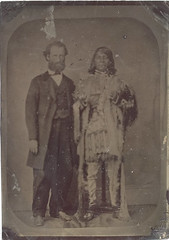 anonymous, 7.5 x 5" copy of a paper image, circa August, 1968. "Tamoostsin" as
he was known among his Nez Perce tribesmen, was baptized in 1839 by Henry Spalding at the Lapwai Mission in what is now western Idaho.
During the Cayuse War of 1847-50 Timothy kept his band at peace with the whites. He was a leader of the Treaty Nez Perce and visited
Washington in 1868 Waldman 2001, Biographical Dictionary of American Indian History to 1900. Perrin Whitman, accompanied his uncle, Marcus,
to the Oregon Territory in 1843, and settled in Idaho, spending most of his life as an interpreter. Accompanied by a photocopy of a
newspaper article in which this image is described and dated.
anonymous, 7.5 x 5" copy of a paper image, circa August, 1968. "Tamoostsin" as
he was known among his Nez Perce tribesmen, was baptized in 1839 by Henry Spalding at the Lapwai Mission in what is now western Idaho.
During the Cayuse War of 1847-50 Timothy kept his band at peace with the whites. He was a leader of the Treaty Nez Perce and visited
Washington in 1868 Waldman 2001, Biographical Dictionary of American Indian History to 1900. Perrin Whitman, accompanied his uncle, Marcus,
to the Oregon Territory in 1843, and settled in Idaho, spending most of his life as an interpreter. Accompanied by a photocopy of a
newspaper article in which this image is described and dated.
Roger Burdette writes:
Interesting. Smithsonian Institution identifications are not perfect and errors are rather common. How tall was Dickeson? Why would he have been in the same location as the Native Americans? Why would he have been photographed with them? Multiple photos with different Native Americans suggests some special connection to a tribe or other group. Did Dickeson have such special status?
Jim Neiswinter writes:
I've got a copy of the picture of the two standing (5 1/2 x 8 1/4). On the bottom is written 'Dr. Montroville Dickeson'. Dickeson is wearing the same clothes and both pictures were taken in the same place. That can be seen by the molding at the bottom of the wall they are standing in front of.
There is also a picture of MWD in Mason's Photographic Gallery In the Feb. 1869 issue of Mason's Coin and Stamp Magazine. This is likely the same head shot of Mason that is to the left in the composite image.
Joel Orosz writes:
Fascinating! Dickeson spent most of the 1840s excavating Indian mounds in the Mississippi Valley. I'm sure he would gotten to know the leaders of some tribes, although probably not always on a friendly basis. The Nez Perce were a Western tribe, but it is true that tribal leaders had been traveling to Eastern seaboard cities at least since the Washington administration. I'm inclined to think it is MWD--it sure looks like him--but I will keep searching for my photo.
In my library I have a print of that very picture made years ago by Bob Wester. It was prepared by Bob Wester in February of 1984. Notes on the back suggest that Wester found the original print of this photo laid in to a copy of the New York Stamp and Coin sale of the Robert Coulton Davis collection (1890).
The original print is erroneously labeled, in a cursive hand, "Dr. Montroville W. Dickenson," Someone, presumably Davis, subsequently crossed out the superfluous first "n.".
Observations:
1. For both the seated and the standing pictures, the hairline appears to be Dickeson's as opposed to being Whitman's. (Dickeson had a pronounced "widow's peak," while Whitman did not).
2. Both the seated and the standing pictures show our subject wearing the same suit and having a left eye that is squinting, at least in comparison with the right. The photo of Whitman does not reveal this eye characteristic. The attached lithographic portrait of Dickeson from the American Numismatical Manual (1859) depicts his left eye slightly narrower than his right.
Of course the reference picture of Whitman was taken when he was an older man than the fellow in the photographs, which does hamper comparisons. However, given the evidence provided by the hairline and the left eye, I'm inclined to think the two photos depict Dickeson rather than Whitman. In addition, Robert Coulton Davis, who lived in Philadelphia as did Dickeson, apparently thought the the man in the standing picture was Dickeson, for he corrected the mistaken spelling under the picture to read "Dickeson."
I cast my vote for the man in both seated and standing photos being Montroville Wilson Dickeson.
To read the earlier E-Sylum article, see:
MORE ON MONTROVILLE DICKESON (www.coinbooks.org/esylum_v15n30a07.html)
EARL & KOEHLER COIN BOARDS BRING RECORD PRICE
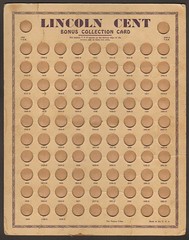
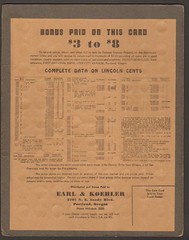
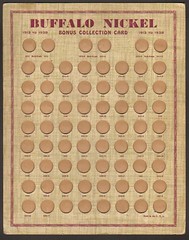
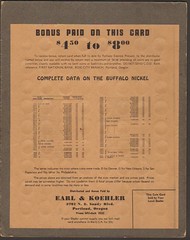
I've just set a new record price for a coin board sale. Recently acquired by me were two very rare coin boards published by the obscure company Earl & Koehler of Portland, Oregon (my article about this firm was included in the program for the ANA Money Show in Portland, recently concluded). The original purpose of these boards was for the buyer to fill them and return the completed boards for a cash premium (the schedule of premiums paid appears on the back of each board).
So rare are E&K boards that they were entirely unknown to me before 2006, despite my having collected coin boards since the early 1980s. The company produced only three titles known to exist today, though it's possible that others were issued but have been lost. The fact that all were sold only out of the partners' Portland variety store accounts for their extreme rarity. Some of the boards were undoubtedly redeemed for the promised premium, and this certainly added to their attrition.
One of the boards I placed with a longtime customer is for Lincoln Cents. Four varieties are known of this board, each being identical except for the color of their face printing. Lange variety EK1¢Ad was printed in a brownish purple, and this example is only the second piece known to me, the better one residing in my own collection. The example I sold grades Very Good-Fine and brought $95, a record for that title though not for coin boards in general.
Even more significant, however, was the extremely rare E&K board for Buffalo Nickels, known only in carmine. Until now this title was unique in my own collection, but a second example was acquired by me along with the cent board, and both were sold to the same advanced collector. The nickel board grades Fine and is nearly equal to my own. This piece has set a record price for any coin board of $225.
While this may seem like a rather paltry figure as compared to the prices for coins, it is a significant milestone in the relatively new hobby of coin board collecting. Prior to the 2007 publication of my book on coin boards I had never paid more than $15 for any item. But the publicity that the book, my website and my newsletters have generated has made it impossible to cherrypick rare boards.
The hobby has enjoyed only modest growth in the overall number of participants, but the competition for rare and choice items has become as intense as any coin auction. It's now well-known which boards are common and worth very little in less than Near Mint condition, but knowledgeable collectors also know when to reach for those boards of exceptional rarity or in exceptional condition.
I obtained these boards from an older woman in Idaho who'd inherited them from her late grandmother. The grandmother lived in Portland. A coin dealer in Idaho purchased the relatively common cents and nickels they formerly held, but the woman also contacted me about purchasing the boards. It took a month of back and forth emails to consummate the deal, and I already had want-lists for these boards from half a dozen collectors when they finally arrived.
The original purchaser from Earl & Koehler was Donald Malay, an amateur antique dealer and coin collector living in or near Portland. It was his coin collection that the seller inherited. Donald's second wife was Leota Harder, the seller's grandmother, and she was left with the coin collection when Donald died around 1970. The coin boards and the coins they held remained within a box inside a cedar chest from that time until recently, passing to the seller in 2013 upon the death of her mother.
LESHER REFERENDUM DOLLARS

The so-called Lesher Dollars were octagonal silver pieces minted by Joseph Lesher of Victor, Colorado, in 1900 and 1901 as part of a larger movement for the cause of free silver, which had particularly strong support locally. After the Crime of ’73 saw the United States effectively demonetize silver and embrace the gold standard, a diffuse alliance of farmers, miners, and their political allies pressed to reintroduce silver currency and concomitantly expand the money supply. The apex of this ongoing struggle was the presidential election of 1896, in which Republican William McKinley defeated William Jennings Bryan and his coalition of free silver supporters. Although Bryan’s defeat seemingly settled the issue nationally, he had received more than 80% of the vote in Colorado, and it continued to roil the politically tumultuous mining districts there through the early twentieth century.
Victor was a boomtown on the western slope of Pike’s Peak, just a few miles southwest of its more famous neighbor, Cripple Creek, where the 1890 discovery of gold inaugurated a decade-long rush into the region. Joseph Lesher was an early arrival and by the turn-of-the-century he was well-known and established figure in the local mining and real estate business. The contentious politics of the county boiled down to a struggle between the heavily working-class mining districts and the more conservative city of Colorado Springs to its west, where many of the mine owners lived.
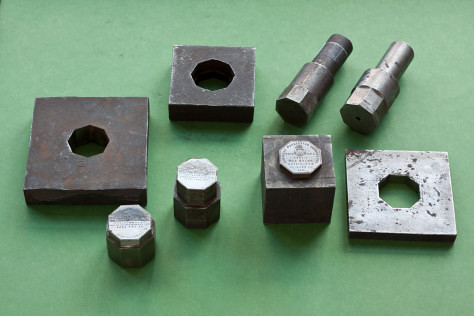
The American Numismatic Society holds fourteen Lesher dollars and some related minting equipment–2 obverse dies, 1 reverse die, 2 punches, and 3 bed plates–that were donated by Farran Zerbe (1871-1949). Zerbe also published a useful account of their genesis in the American Journal of Numismatics in 1917 that drew from an in-person visit with Joseph Lesher some years prior. As Zerbe points out, Lesher was clearly in a very grey legal area vis-à-vis the United States government, which held a monopoly on issuing hand-to-hand currency. He differentiated his silver pieces from government money with an octagonal shape and an inscription on the obverse that read JOS LESHERS REFERENDUM SOUVENIR. The dies for this initial issue of one hundred pieces were cut by Frank Hurd and struck by metal stampers in Denver. They were composed of silver .950 fine with copper alloy, weighed 480 grains (equivalent to one troy ounce), and measured 35mm in diameter.
To read the complete article, see:
LESHER REFERENDUM DOLLARS
(www.anspocketchange.org/lesher-referendum-dollars/)

RECYCLERS DEFRAUD U.S. MINT WITH CHINESE COUNTERFEIT COINS
Federal investigators in New Jersey say they have uncovered a $5.4 million plot to defraud a U.S. Mint-run program that redeems unusable dimes, quarters and half dollars.
In court papers filed last week, federal prosecutors lay out a daring scheme led by several U.S.-based metal recyclers - one based in New Jersey -- to import counterfeit coins from China in an effort to take advantage of the U.S. Mint's century-old Mutilated Coin Program.
The program pays recyclers nearly $20 per pound for dimes, quarters and half dollars that have been bent, broken, corroded or no longer can be counted by machine.
The suspicions of investigators with U.S. Customs and Border Protection were raised in 2009 after they witnessed an uptick in shipments of mutilated coins coming through the Port of Los Angeles, prosecutors say. They reported their concerns to Homeland Security Investigations.
Most of the shipments were coming from China, with recyclers claiming the coins were discovered in cars exported to China as scrap metal, prosecutors say.
Among the tip-offs for investigators was the number of half dollars coming in from China for redemption outpaced the total the U.S. Mint has made, they say.
"Interestingly, United States Mint personnel also believe that more half dollars have been redeemed by China-sourced vendors in the last 10 years than the United States Mint has ever manufactured in its history," according to a forfeiture complaint filed in U.S. District Court on March 20 by Assistant U.S. Attorney Lakshmi Srinivasan Herman.
A sampling of the coins, valued at nearly $400,000, showed that they contained aluminum and silicon, elements not present in coins manufactured by the U.S. Mint, they say.
And the coins were all "mutilated" in a similar fashion, prosecutors say. They were "mechanically cut or deformed and corroded by some type of unknown chemical before being washed," the court papers say.
Prosecutors say Loung, along with other metal recyclers, have claimed that the coins they redeemed in the U.S. were found in cars exported to China for scrap metal.
But a 2009 analysis by Customs and the U.S. Treasury's Office of the Inspector General compared the numbers of cars exported to China against the number of damaged coins imported from China, court papers say.
"There would have to be approximately $900 in coins in every vehicle ever exported to China as scrap metal in order to account for the total amount of waste coins imported from China for redemption," Herman writes.
The second largest importer of scrap metal from the U.S. is India and, to date, the U.S. Mint has not received any mutilated coins from there, the complaint says.
Each year, according to the complaint, the U.S. Mint loses money with its mutilated coin program "because it only makes a profit on the metal it recovers, which is much less than the redeemed value."
To read the complete article, see:
Recyclers try to defraud U.S.
Mint with counterfeit coins from China, feds say (www.nj.com/news/index.ssf/2015/03/feds_uncover_scheme
_to_defraud_us_mint_out_of_54m.html)
A SHORT HISTORY OF THE FRANKLIN MINT
David T. Alexander writes:
I read with interest Q. David Bower's comments on Joe Segel and the Franklin Mint. Joe was well away from FM when Morley Safer did his all-too-true 60 Minutes presentation. About the only loyalist left in the numismatic community was the late Russ Rulau, who felt the need to defend FM thanks to his long friendship with the late Virginia Culver, author of the guide "Numismatic Issues of the Franklin Mint."
FM was a uniquely successful merchandizing phenomenon. It was never really a factor in the rare coin market except in a negative sense, siphoning vast amounts of money from the general public that could not then be spent on real collector coins. FM dealt in modern medallic material and world coins largely sold to new or non-collectors who then blamed the numismatic market for the loss in value of their FM material.
I attach a story I wrote in 2003, detailing at first hand the saga of FM's early years. My late brother John L. Alexander (1938-1987) played a key role in this history. One artful technique employed by Segel was the presentation of FM stock to numismatic groups, which might feel less inclined to criticize FM policies. An exception was the Society for International Numismatics (SIN) which promptly sold its FM stock to assure its continued independence.
The Franklin Mint was not always a world-sized marketing phenomenon, and few collectors are familiar with the formative years of its remarkable saga. Collectors who associate the name Franklin Mint with the millions of coins struck by it for an endless array of governments, the medal and ingot series for which it became famous may not realize that most of its 1965 production was base metal gaming tokens struck for 27 casinos, mostly located in Las Vegas and Reno, Nevada.
The present writer observed the Franklin Mint’s explosion onto the numismatic scene at first hand in 1966. His brother, the late John L. Alexander (1938-1987) was a stock broker instrumental in the underwriting of the mint’s first common stock listed on the National Stock Exchange. The mint was then only one area of interest of a parent firm called General Numismatics Corporation (GNC), whose home town was Yeadon, Pa., not yet renamed Franklin Center.
John Alexander’s research in this dynamic young company interested his employers, the stock brokerage house of Hill, Darlington and Grimm is making the Franklin Mint one of its successful new stock issues. The story of the stock issue and of the beginning years of the Franklin Mint is basically the story of its founder, one-time advertising specialties prodigy Joseph M. Segel.
Segel personified the go-getting American entrepreneur, founding GNC in 1964 with an investment of $21,000. His business experience was already extensive and unusually successful. At the age of 13, he had launched a successful printing business before entering the Wharton School of Business administration in Philadelphia, Pennsylvania.
Coin collecting brought itself forcefully to his attention during the first great surge of silver prices in 1964. The public stormed the nation’s banks, eager to redeem their Silver Certificates for silver dollars from long-ignored Treasury stocks and later for silver granules from the national stockpile. Watching block-long lines form outside area banks, the young businessman became fascinated by the business possibilities offered by coin collecting.
He reasoned that if fortunes were being made in selling existing coins, adding to the supply of collectible numismatic items by manufacturing high quality coins and medals might be just as profitable.
Segel’s first step in numismatics was organizing the National Commemorative Society (NCS) in 1964. The first six NCS medals predated GNC and were struck elsewhere, but the society was Segel’s first venture in the field of ``limited edition’’ collectibles. They were struck in Sterling silver, the 92.5% pure silver alloy beloved of silversmiths over the centuries. NCS issued one 39-millimeter medal each month, coin-like objects combining low relief and Proof surface.
These early issues were given the oxymoronic name of “coin-medals.” A vast majority of collectors in 1964 sought coins and avoided medals, and Segel resorted to this hybrid term to overcome this widespread collecting limitation. Over the next several years, the Franklin Mint would trigger repeated debate through its sometimes innovative vocabulary.
Segel’s NCS closed its subscriber list at only 5,249 members. In the next years, several other membership series were created, however, honoring famous women, the history of the Catholic Church, U.S. Presidents, international Freemasonry, space exploration and British history.
A major event was the hiring of retiring U.S. Mint Chief Engraver Gilroy Roberts, creator of the Kennedy half dollar by the new GNC in 1965. With remarkable courage, Roberts left a secure, if non-spectacular U.S. government civil service post to join a new and untried venture. Before his death in 1992, Roberts became a wealthy man as Chairman of the Board of the Franklin Mint.
His creative opportunities were unlimited in his new post, and in these early years great honor was paid to the Franklin Mint’s artistic staff. The name Gilroy Roberts “sold,” and good use was made of it in merchandizing the mint and its rapidly growing range of products.
Segel possessed limitless self confidence. Where others eased into competitive situations, testing the waters, he was inclined to plunge right in. During the search for substitute metals for U.S. silver coinage, he made Franklin Mint an active participant with a cased three-piece set of dollar-size pieces called “Pattern Trial Proofs” designed by Roberts with the theme of Gardiner’s Island and its colony of fishing hawks or ospreys, located near the eastern tip of Long Island, N.Y.
A commemorative medal was struck for the successful listing of GNC stock on the National Stock Exchange, Feb. 1, 1967. It featured Gilroy Robert’s bust of Benjamin Franklin facing ¾ l. on its obverse, an old-fashioned glass-domed stock ticker on the reverse with the stock symbol GNC. Medals struck were 376 in Sterling and 3,750 “Nickel-silver.”
Market value of all Franklin Mint material became a problem as the 1970’s approached. At the time of the 1967 ANA convention, Segel toyed with an idea that might have created a stable after-market for Franklin Mint issues. This was to have been a bureau directing collectors seeking past issues to possessors of such medals. Such an agency could have fostered and directed a genuine second market for Franklin Mint material, assuring retention of both value and interest.
In an inexplicable change of heart, Segel rather off-handedly abandoned this idea. No worthwhile secondary market was ever to develop, paving the way for that catastrophic loss of value that soon made nearly all Franklin Mint sets and singles a source of despair and loss for their owners and the butt of ridicule or hostility throughout the numismatic hobby.
In fairness it must be emphasized that there were no legitimate complaints about the purity or quality of Franklin Mint products at any time. The mint’s Proofs were always of the finest and the silver and eventually the gold offered to Franklin Mint product buyers could not be faulted. Only the vexed question of plummeting value after the first purchase remained a running sore that never healed.
Some observers believe that over the years, surviving Franklin Mint coins and medals will slowly gain in value, as long as the supply is permanently ended. This happened, they point out, with many collector coins of the 1870’s and 1880’s that were marketed as unofficial patterns. No doubt the 1979-80 melts and the end of new issues will focus some collector interest on what will be a closed book. The ways of collectors are surely remarkable!
To read the earlier E-Sylum article, see:
NOTES FROM E-SYLUM READERS: MARCH 22, 2015 : Joseph Segel and the Franklin
Mint (www.coinbooks.org/esylum_v18n12a11.html)
ARTICLE PROFILES D. BRENT POGUE
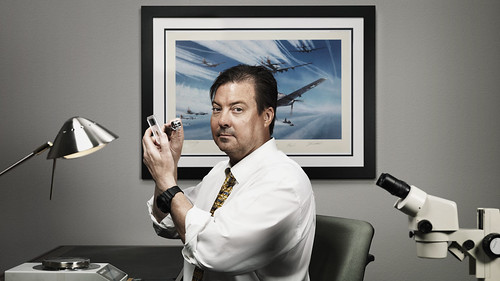
D. Brent Pogue
The 650 coins in the Pogue Cabinet, amassed over 35 years, are “going to sail past the nine digits,” Bowers says confidently. According to presale estimates, the auctions are expected to bring in more than $200 million for what New Jersey coin dealer Laura Sperber recently described as “the ultimate coin collection.”
The 50-year-old Pogue is the first to admit it didn’t start out like that. In 1974, when he was 9 years old, his father, Dallas real estate developer Mack Pogue, brought home a sack of old pennies and a price guide to give the boy a hobby. Mack told his son he had paid $100 for the bag, and Brent had a seven-day option to purchase it for $110. “My business instinct kicked in,” Brent recalls. He picked out a 1915 cent that he appraised at $80 because it was so shiny. “I exercised my option within 20 minutes.”
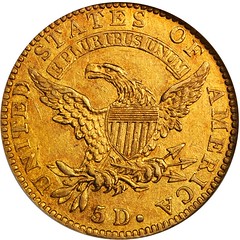 As Pogue’s knowledge broadened and his connoisseurship deepened, his focus narrowed to the first
half-century of American coinage, when dies were still engraved by hand. By 1982 his father trusted his judgment enough to buy an 1822 $5
gold piece (above) at auction for $687,500. (It was one of three known to have survived; the other two are in the Smithsonian.) “I knew we
had to buy the coin because it would let us put together a complete set,” Pogue says. “It’s the kind of coin that could go away for 50
years once it’s sold.”
As Pogue’s knowledge broadened and his connoisseurship deepened, his focus narrowed to the first
half-century of American coinage, when dies were still engraved by hand. By 1982 his father trusted his judgment enough to buy an 1822 $5
gold piece (above) at auction for $687,500. (It was one of three known to have survived; the other two are in the Smithsonian.) “I knew we
had to buy the coin because it would let us put together a complete set,” Pogue says. “It’s the kind of coin that could go away for 50
years once it’s sold.”
Pogue has managed the family holdings ever since, spending four decades patiently gathering the full run of early federal coinage in the best available condition–”a collection representing our country’s economic birth,” as he describes it–driven by his modern business sense. “You have to be opportunistic, and you have to have guts,” he says. At one auction that meant bidding $4.1 million on the legendary 1804 silver dollar–in the finest condition of eight known–spending more than twice as much as had ever been paid for any coin at auction.
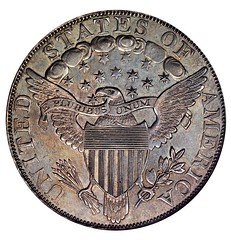 That was in 1999. The following year another 1804 dollar came up for sale. Still stunned by how much he
and his son had splurged the first time, Mack Pogue wanted nothing to do with it–yet Brent prevailed upon his father to spend another $1.8
million. “I thought he was going to put his hands around my neck,” Brent recalls. “I told him he had to protect his investment.”
That was in 1999. The following year another 1804 dollar came up for sale. Still stunned by how much he
and his son had splurged the first time, Mack Pogue wanted nothing to do with it–yet Brent prevailed upon his father to spend another $1.8
million. “I thought he was going to put his hands around my neck,” Brent recalls. “I told him he had to protect his investment.”
From that point forward the Pogues just kept going, with Brent increasingly thinking of the hobby as a business and himself as a manager. “I regard myself as the steering wheel of this collection,” he says. “My family is the gasoline.” The combination has been formidable, overcoming even the toughest of obstacles: fellow collectors who have no intention of selling.
One recent transaction took more than three years of bartering with a World War II veteran living in Ingalls, Ind. “He had metal fragments all through his body and an amputated leg, and the last thing you want is to negotiate with a man who survived all that,” Pogue says. But the vet’s collection of 200 coins included a few key pieces that the Pogues needed, such as a 1793 chain cent–the nation’s earliest penny–in gem mint state, the finest in existence.
So why sell the family’s core holdings now? “In my mind the collection is complete,” Pogue says. “Some of these coins have been off the market for 35 or 40 years. It’s time to share them with the numismatic community.”
“These sales will be very good for the coin market,” Bowers says. “Very, very few people in numismatic history have ever put together a collection like this. It will be a once-in-a-lifetime opportunity to own some of these coins. A record price now will be a bargain in ten years.”
To read the complete article, see:
The $200 Million Pogue Coin
Collection Comes Up for Auction (www.forbes.com/sites/jonathonkeats/2015/03/25/pogue-coin-collection-auction-stacks-bowers/)
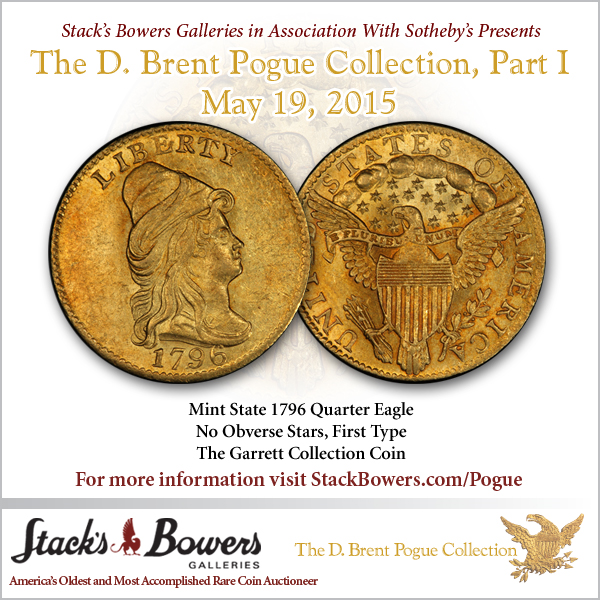
THE BUSHNELL-PARMELEE BIRCH CENT BRINGS $1.2M
A handful of copper Birch Cents would have bought a meal of cold meat and a pint of beer at an early 19th-century American tavern, but at an auction in Baltimore late Thursday night, one fetched nearly $1.2 million.
"Going once, looking for $1.1 million," cried auctioneer Melissa Karstedt, standing on the podium of a carpeted room at the Baltimore Convention Center during the Whitman Coin & Collectibles Expo, which runs through Saturday. "Going twice, any advance on $1 million? Last call. … Sold for $1 million to bidder 280."
In the catalog published by the expo auctioneer, Stack's Bowers Galleries, the "The Magnificent Bushnell-Parmelee Jenks-Col. Green 1792 Birch Cent" was described as "simply, the first of a cultural phenomenon that is known the world over: it is the first American cent."
Stamped in Philadelphia in the summer of 1792, the coin was named for its designer, Robert Birch. About the size of a modern quarter, it bears on one side a profile of Lady Liberty, her wavy hair flowing, and on the other a wreath.
A 1792 cent made of copper with a silver plug in the center went for $499,375. The silver-copper cent was the result of a collaboration between Thomas Jefferson and American revolutionary Thomas Paine. Letters show that the two men exchanged ideas about coinage at the time, with Paine suggesting the hybrid copper-silver penny, also showing Lady Liberty on one side and a wreath on the other.
Vicken Yegparian, Stack's Bowers' vice president of numismatics — the study or collection of currency — said he was happy with the price of the Birch Cent.
"Any million-dollar thing in numismatics is significant," he said. "It's not every day you sell a million-dollar rarity."
An array of motivations drive coin collectors, said Yegparian, who has been with the company for 15 years and collecting coins himself for about 30 years.
"The primary motivation is a love of history, a love of the beauty and the lore of the coin," he said. "In the top-tier pieces, some of it is just bragging rights: 'I have something you don't.'"
To read the complete article, see:
Early American penny fetches more than $1 million at
Baltimore auction (www.baltimoresun.com/business/bs-bz-auction-coins-20150325-story.html)
Dick Hanscom forwarded this Daily Mail version of the story, and they chose to republish a photo of a hirsute coin dealer.
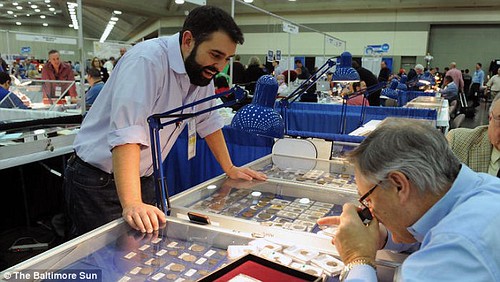
To read the complete article, see:
Prototype US penny sold for
$1.175million to anonymous bidder during auction
(www.dailymail.co.uk/news/article-3014725/Prototype-US-penny-sold-117-5-million-pennies.html)
REPORTER INTERVIEWS KRALJEVICH ON COIN RARITIES
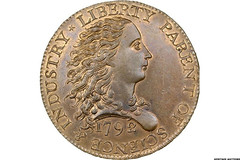 High-rolling bidders competing for a unique bit of American history are expected to shell out at least six figures per coin. Each have
their own unique story behind them – the half dollars, for example, were the only coins the Confederacy ever made.
High-rolling bidders competing for a unique bit of American history are expected to shell out at least six figures per coin. Each have
their own unique story behind them – the half dollars, for example, were the only coins the Confederacy ever made.
“Only four were struck and they were handed to VIPs: Jefferson Davis got one,” says John Kraljevich, a senior numismatics consultant for Stack’s Bowers Galleries and independent rare coins business owner.
Confederate coin production didn’t get far, not because of the Civil War, but because the amount of silver it took to manufacture the coins ended up costing more than the coins were worth. Instead, the Confederacy opted to use Mexican coins instead, which were easy to come by, according to Kraljevich.
“They were the only coins ever produced by the South,” he says.
Those weren’t the only coins to have problems incorporating silver into their manufacture. The 1792 silver-center cent had a hole drilled into the middle, which was fitted with a silver bit. The idea for the silver plug can be traced back to correspondence between Thomas Jefferson and Thomas Paine.
“Paine came up with the suggestion that the coin should be three-fourths copper and a quarter of silver put together,” says Kraljevich. The Founding Fathers and minters were afraid the coin wouldn’t be taken seriously, and they felt adding silver would give the coin some monetary weight, says Kendrella. But it also gave the coin more physical weight, and because of that and also because of technological difficulties in manufacturing it, it was discontinued.
Speaking of silver, the half-disme comes with its own slice of American lore. According to Kendrella, the legend goes something like this: George Washington, in an effort to speed up the coinage process after enacting the Mint Act, melted down his own silver cutleries to make those 1,500 silver half dismes of 1792.
It’s a good story, but the buck stops there. According to Kraljevich, the tale should be thoroughly filed under legend.
“It was actually Jefferson who recorded depositing silver at the U.S. mint in Philadelphia in 1792, then received 1,500 half dismes back from the mint just a few days later," says Kraljevich. "So either someone misremembered and confused Washington for Jefferson in the 1840s or it's just totally made up.”
The Birch cent, along with the silver cent piece, were precursors to the penny, which was first struck with 100% copper in 1793. In 1982, the penny was replaced with copper-plated zinc.
So what makes rare coins so special?
In Kraljevich’s view, it’s because many coin collectors started as kids, became successful and are now able to spend as much as they want on their collection.
“They recall those childhood memories of, ‘Wow it’d be really cool to own that,’" Kraljevich said. "It’s one of those things that some of those people are striving to own—it’s, ‘I’ve wanted to own these my whole life.'”
To read the complete article, see:
A Penny for Your Bank
Account: Rare Coins to Fetch Millions at Auction
(www.mainstreet.com/article/a-penny-for-your-bank-account-rare-coins-to-fetch-millions-at-auction)
HISTORY OF THE NATIONAL NUMISMATIC COLLECTION
 My first encounter with the Smithsonian collection of numismatics occurred nearly three decades ago. While
in the Washington D.C. area I planned a visit to the Smithsonian Museum of American History to see what coins they might have on exhibit.
My interest in rare coins was still fresh and very impressionable. I can still remember the sense of awe when viewing the nearly 3,000
square feet of rare coins for the first time. There were cases explaining the history of coinage, early American numismatics, and other
educational subjects relating to numismatics. The highlight however, was the room full of gold coins!
My first encounter with the Smithsonian collection of numismatics occurred nearly three decades ago. While
in the Washington D.C. area I planned a visit to the Smithsonian Museum of American History to see what coins they might have on exhibit.
My interest in rare coins was still fresh and very impressionable. I can still remember the sense of awe when viewing the nearly 3,000
square feet of rare coins for the first time. There were cases explaining the history of coinage, early American numismatics, and other
educational subjects relating to numismatics. The highlight however, was the room full of gold coins!
In 1968, the Smithsonian acquired the massive gold collection of Josiah Lilly. His nearly complete collection of United States gold coins and gold coins from around the world were on display, mounted in row after row on the wall. It was literally a golden room, filled with the rarest of the rare. I think my intense interest in United States gold coinage began that day. Little did I know that two decades later I would write the Encyclopedia of United States Gold Coins based on the Smithsonian Collection.
The origins of the Smithsonian itself began with a numismatic angle. The James Smithson donation to found the Smithsonian Institution was made with 104,960 gold English sovereigns. The coins were deposited at the Mint for re-coining into United States money- $508,318.46. Today the museum still has two of the original 1838 gold sovereigns in its collection. It also has a stunningly perfect example of an 1838 United States half eagle made from the gold turned in for melting.
Although the United States received the bequest from James Smithson in 1838, it was not until an Act of Congress on August 10, 1846 establishing the Smithsonian Institution which was signed by James Polk. On May 1, 1847, the cornerstone of its first building was laid on the Mall. You can visit the first buildings today with a short stroll across the Mall to the Smithsonian Castle. They are open to the public and feature a rotation of exhibits. It is like stepping back in time and visiting one of the oldest museums in the country as it looked in the 1840’s. In those days most exhibits centered on what were called “Natural Curiosities’. This might include rare minerals, skeletons and mounted animal displays.
It was not until the 1880’s that much interest was given to the collecting of numismatic material at the Smithsonian. In those days the collecting of medals was of primary interest in the museum. The centennial exposition of 1876 in Philadelphia provided a tremendous amount of new material for the collection. In fact, the Smithsonian received so much material from the exposition, numismatic and non- numismatic, that a new structure was erected to house the collection. The Arts and Industries Building is now part of the Castle complex, and can be visited today as well. It is a beautiful example of state of the art museum faculties from the 1880’s.
The most important event in the history of the National Numismatic Collection occurred in 1923. Around this time period, the United States Mints were closed due to a robbery at the Denver Mint. Also, the curator of the Mint Collection, Dr. T. Louis Comparette died suddenly. Because of the robbery, the Secretary of Treasury, Andrew Mellon, suggested that the United States Mint transfer its collection to the National Collection in Washington, D.C.
In May 1923, the United States Mint transferred 18,324 of the greatest coins in the world to the Smithsonian Institution. Although the Mint Collection was officially started in 1838, the collections roots can be traced to the beginning of Mint operations in 1792. The Chief Coiner, Adam Eckfeldt, carefully saved what at the time were called “master coins” of each year. These are today more commonly referred to as Proof or Specimens. Eckfeldt also saved coins that had been re-deposited at the Mint for re-coinage. An example of the famous Brasher doubloon was obtained in this manner.
Making a list of all of the important coins given to the Smithsonian in 1923 would take pages and pages. Just a few of the more famous coins include the 1849 Double Eagle, an 1804 Silver Dollar, an 1822 Half Eagle, both 1877 Gold Unions, Multiple 1907 Ultra High Reliefs, and an incredible run of early Proof coinage that began in 1817. The transferred collection also included over 100 Patterns coins, many of which are unique. Pioneer gold coins are also heavily represented, with many examples being the finest of their kind in the world.
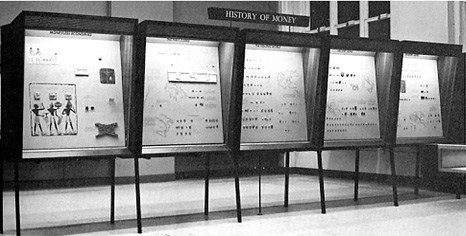
To read the complete article, see:
Brief History of the National Numismatic
Collection (http://news.coinupdate.com/brief-history-of-the-national-numismatic-collection-4753/)
THE BOOK BAZARRE
HOWARD BERLIN VISITS RIGA, LATVIA
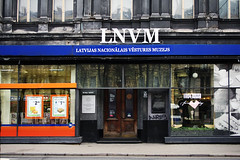 After an overnight stay in Berlin, I headed for Latvia’s capital city, Riga, on the third of
nine flights I would take on this 12-day European trip. Here, there are two numismatic exhibitions. The first one I went to see was the
“semi-permanent” exhibit of the National History Museum of Latvia. I use the term “semi-permanent” as the numismatic part of the museum’s
exhibition is still a work in progress. It is housed in a temporary location in a neo-Renaissance style building that was built in 1875, as
the Riga Castle, which originally housed the National History Museum (plus several other state museums and the residence of Latvia’s
president ), was severely damaged by a 2013 fire. It may not be until 2018 when the permanent exhibition will be relocated back at the
castle.
After an overnight stay in Berlin, I headed for Latvia’s capital city, Riga, on the third of
nine flights I would take on this 12-day European trip. Here, there are two numismatic exhibitions. The first one I went to see was the
“semi-permanent” exhibit of the National History Museum of Latvia. I use the term “semi-permanent” as the numismatic part of the museum’s
exhibition is still a work in progress. It is housed in a temporary location in a neo-Renaissance style building that was built in 1875, as
the Riga Castle, which originally housed the National History Museum (plus several other state museums and the residence of Latvia’s
president ), was severely damaged by a 2013 fire. It may not be until 2018 when the permanent exhibition will be relocated back at the
castle.
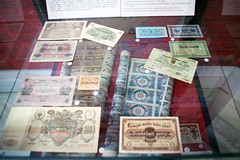 I was met by the museum’s chief curator, Dr. Anda Ozolina who briefly gave me an
overview of the museum and then left me to explore on my own. Only bits and pieces of the collection that was in the castle are currently
on display, which are integrated among other historical artifacts. Most items were banknotes from the 1918-1940 period of the Latvian
Republic and did not include Medieval and Livonian specimens, or 17th century coin hoards. Unfortunately for me, much of the text material
was only in Latvian so it was difficult to ascertain the significance of the many displays.
I was met by the museum’s chief curator, Dr. Anda Ozolina who briefly gave me an
overview of the museum and then left me to explore on my own. Only bits and pieces of the collection that was in the castle are currently
on display, which are integrated among other historical artifacts. Most items were banknotes from the 1918-1940 period of the Latvian
Republic and did not include Medieval and Livonian specimens, or 17th century coin hoards. Unfortunately for me, much of the text material
was only in Latvian so it was difficult to ascertain the significance of the many displays.
 After leaving the museum and walking back to my hotel, I passed a
7-11 type convenience store which also sells wine and liquor. I was looking for a bottle of slivovitz (aka slivovice) – which is a plum
brandy, typically 85 to 100 proof, that is popular in the Czech Republic and a few other East European countries which my family drinks it
every Friday night after dinner. The store didn’t have any but at one end of the building I saw a shop that sold coins, banknotes, gold
bullion, and numismatic supplies. Besides the large selection of pre-euro Latvian and other foreign coins and notes, I noticed a small
selection of U.S. coins and a $10 bill on the cashier’s window which also doubled as a foreign exchange spot.
After leaving the museum and walking back to my hotel, I passed a
7-11 type convenience store which also sells wine and liquor. I was looking for a bottle of slivovitz (aka slivovice) – which is a plum
brandy, typically 85 to 100 proof, that is popular in the Czech Republic and a few other East European countries which my family drinks it
every Friday night after dinner. The store didn’t have any but at one end of the building I saw a shop that sold coins, banknotes, gold
bullion, and numismatic supplies. Besides the large selection of pre-euro Latvian and other foreign coins and notes, I noticed a small
selection of U.S. coins and a $10 bill on the cashier’s window which also doubled as a foreign exchange spot.
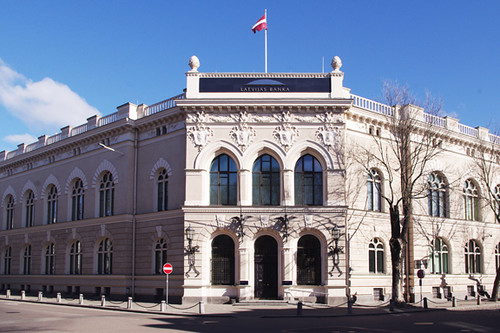
National Bank of Latvia
The other notable exhibition in Riga was the Naudas Pasaules (Money World) exhibition at the Bank of Latvia’s Visitor Center, which is across the square from the Riga Castle. Generally, admission is only done by web-registration, and the next available opening for tours would be several days after I would leave Riga. Luckily, an e-mail followed by a phone call to the bank circumvented this process and I had an appointment to see the exhibition the day before I was to depart Riga. Similar to some of the Federal Reserve Banks and many other central banks that have exhibits, a photo ID or passport was required for admission to receive a visitor’s badge.
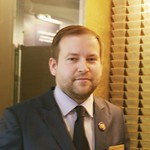 The bank’s exhibition has been around for about 10 years and will close down in a few months so that the area can be expanded and will
probably reopen about a year later in 2016. In the lobby I was met by Kaspars Kravinskis, the exhibit’s manager, who graciously took time
out of his busy schedule to give me a one on one tour of the exhibition.
The bank’s exhibition has been around for about 10 years and will close down in a few months so that the area can be expanded and will
probably reopen about a year later in 2016. In the lobby I was met by Kaspars Kravinskis, the exhibit’s manager, who graciously took time
out of his busy schedule to give me a one on one tour of the exhibition.

National Bank of Latvia exhibit
The exhibition area was quite impressive with its displays, interactive computer screens that provided identical information in Latvian, Russian, and English.
Next week: Bucharest.
QUERY: MANKATO DAKOTA INDIANS HANGING ITEMS SOUGHT
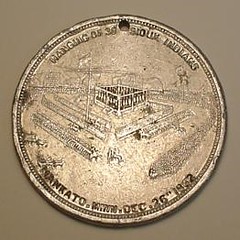
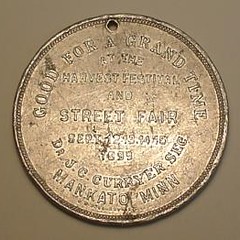
I recently finished reading a fascinating book titled 38 Nooses: Lincoln, Little Crow, and the Beginning of the Frontier's End by Scott W. Berg about a significant (but little-known) event in U.S. history: the mass execution of 38 Dakota Indians by hanging on December 26, 1862, at Mankato, Minnesota.
Having been a student of American history most of my life, I was surprised (and a little embarrassed) that I had never before come across accounts of this event. The book itself was a great read (and I would recommend it to anyone interested in learning more about the events of the Dakota War), but I was curious to find out if readers of The E-Sylum were aware of numismatic representations of this event? A Google search did turn up this 1899 Mankato street fair merchant token/medal with a depiction.
To read the complete Token Catalog record, see:
http://tokencatalog.com/token_record_forms.php?action=DisplayTokenRecord&td_id=98523&inventory_id=
49439&attribution_id=99292&td_create_uid=252
ALASKA CENTENNIAL MOOSE GOOSER MEDALS

The Purchase Centennial year was celebrated throughout the state. Anchorage and Fairbanks greeted two new railroads. Granted, these were not the freight bearing type of railroad, but railroads set up for entertainment during the celebration.
Officially the “Kiwanis-New York Life Centennial Steam Railroad,” but known as the Moose Gooser, this train ran from the Alaska Rail Road depot to the International Airport. From the advertising brochure, we learn:
“The Moose-Gooser, one of the very few steam railroads in operation today, is the joint project of the Anchorage Kiwanis Clubs, the New York Life Insurance Company, and the Anchorage Centennial Commission.
“For the railroad buff or the old-timer, the Moose-Gooser has nostalgic memories of the great days of steam railroading. For children, it’s the thrill of a lifetime to ride behind the puffing, chugging, whistling old steam engine, looking like it had just emerged new and glittering, straight from the distant past. For all others, it’s an amusing and refreshing experience to ride this unique train, built solely for the purpose of amusement.
“It consists of a 2-8-2 Mikado type engine, built in 1829 by the Baldwin Locomotive Works for the Comox Lumber Company of British Columbia. This engine has been leased from the West Coast Railway Association in Vancouver, B.C., and must be returned to that organization at the close of the Alaska Centennial.
The Moose Gooser was honored with four medals: cupro-nickel and brass, with the train moving to the right, and a cupro-nickel with the train moving to the left. Kurtis Hawk reports that there were also 20 minted in sterling silver. Is the train moving left or right?
To read the full auction catalog, see:
FAIRBANKS AUCTION - SPRING 2015.
(http://alaskararecoins.coffeecup.com/files/Download/auction69.pdf)
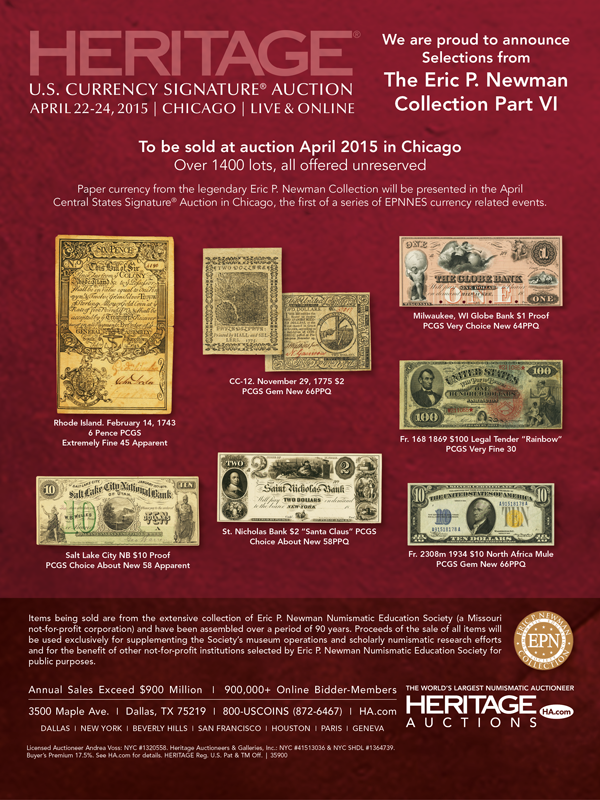
NYPD CHALLENGE COIN FEATURES SHERLOCK HOLMES

The Latent Print Section of New York’s Police Department issued a challenge coin featuring Sherlock Holmes in early 2015.
For those not familiar with the concept of a challenge coin, it works like this. Traditionally, groups issued these coins to its members offer proof of belonging to the group and to increase morale within that group. When gathered together, using in an drinking establishment, someone will display their coin and challenge the others to produce theirs. This is called a coin check. Those that cannot produce their challenge coin will then have to buy a round of drinks for the challenger and all those that produced their coins. If all members challenged can present their coin, then the challenger has to buy the round of drinks. However, these traditions can vary from group to group.
OBVERSE: LATENT PRINT SECTION / (silhouette of Sherlock Holmes, facing left, with deerstalker cap and pipe, holding a magnifying glass in his right hand, the design mimics a fingerprint) / NYPD
REVERSE: (triangular patch of the New York Police Department) over a background design of a fingerprint
51mm, Round, Nickel Finish, Swirl Edge Cutting
Now, if we could only see Detective Bell and Captain Gregson challenge their fellow officers in a bar scene on an upcoming episode of Elementary…
To read the complete article, see:
Sherlock Holmes Featured on NYPD Challenge
Coin (http://fourthgarrideb.com/2015/03/sherlock-holmes-featured-on-nypd-challenge-coin/)
ORDER OF THE BATH MEDAL
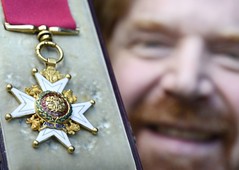 The fourth-highest military order is to hit the auction-house on Sunday and is expected to be a popular
item.
The fourth-highest military order is to hit the auction-house on Sunday and is expected to be a popular
item.
The Most Honourable Order of the Bath, or lot 380 as it’s known at Alnwick Auctions, has been given a humble estimateof £1,500, but is expected to sell for much more.
The 22-carat-gold medal is mainly awarded to officers of the Armed Services, as well as to a small number of civil servants.
Alnwick Auctions owner Nigel Blagburn said that he’s had interest as far as London about the sale.
By the end of the 15th century, the ceremonial rituals disappeared but it was revived by George I in 1725 as a military order, to serve the purposes of the first Prime Minister, Sir Robert Walpole, who required an additional source for political rewards.
The medal at auction is believed to have come from around the 1850s, which would make it one of the first awarded around the time of the Crimean War, although this is not confirmed.
To read the complete article, see:
Rare medal
up at auction attracting national interest
(www.northumberlandgazette.co.uk/news/local-news/rare-medal-up-at-auction-attracting-national-interest-1-7176708)
ARTICLE PROFILES ERROR COIN DEALER FRED WEINBERG
 Known as a specialist in error coins and the minting process, and as an author on those subjects,
Fred Weinberg from Fred Weinberg & Co. said he never intended to make a career from the hobby he was introduced to at age 9. Weinberg is
also a specialist in U.S. gold coins.
Known as a specialist in error coins and the minting process, and as an author on those subjects,
Fred Weinberg from Fred Weinberg & Co. said he never intended to make a career from the hobby he was introduced to at age 9. Weinberg is
also a specialist in U.S. gold coins.
While in college in Southern California in 1972, Weinberg said, he received a phone call from Jonathan’s Coins, in Inglewood, Calif., one of the largest coin shops in the country, to come to the shop and help in the purchase of a collection of error coins.
“I drove down to the shop, bought the deal, and the owner offered me a job, right then and there,” Weinberg said. “It took me three or four days to be able to tell my parents that I was quitting college and becoming a full-time coin dealer.”
“In 1972, at least [from my perspective] in Los Angeles,” Weinberg said, “the coin business consisted of coin shops, Coin World, a few coin shows, and a relatively small number of national coin dealers. Stack’s, Bowers and Ruddy, Paramount, as well as Lester Merkin, Abe Kosoff, Jerry Cohen and Abner Kreisberg, Art Kagin, Q. David Bowers, Audrey Bebee are just a very few of the older ‘names’ that I remember meeting at that time, at the larger shows in Southern California.”
Local coin shops all seemed to be the same — small, smoky, somewhat messy and unorganized, especially in the back offices, Weinberg said.
After working at Jonathan’s Coins for a year, Weinberg said, he was offered a job by collector-turned-dealer Harry Gordon of Numismatics Ltd., in Beverly Hills.
Weinberg said that, starting in 1973, he began accompanying Gordon to Europe, visiting banks and coin dealers in Switzerland, France, England, Germany, Lichtenstein, and other places, buying thousands of U.S. gold coins every six to eight weeks.
One of those trips, in 1977, yielded a copper rarity — a 1794 Liberty Cap, High Relief half cent. Weinberg acquired the coin plus a 1916 Standing Liberty quarter dollar at a small coin show outside Zurich for the equivalent of $1,200 in U.S. funds.
The half cent was subsequently placed for $35,000 in 1978 into what eventually became known as the Missouri Cabinet.
The 1794 half cent, now graded PCGS MS-67 ... realized $1.15 million when it was sold Jan. 26, 2014, at the Missouri Cabinet auction by Ira & Larry Goldberg, Auctioneers.
To read the complete article, see:
Fred Weinberg makes a living off
of other people's mistakes (www.coinworld.com/insights/coin-production-errors-bread-and-butter-for-fred-weinberg.html)
TEENAGE TRIUMPHS OF Q. DAVID BOWERS
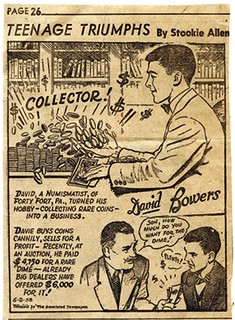 Our hobby is ripe
for entrepreneurship for those willing to work. This 1958 cartoon features hobby legend Q. David Bowers as a teenager who “turned his hobby
— collecting rare coins — into a business.” Image courtesy of Q. David Bowers.
Our hobby is ripe
for entrepreneurship for those willing to work. This 1958 cartoon features hobby legend Q. David Bowers as a teenager who “turned his hobby
— collecting rare coins — into a business.” Image courtesy of Q. David Bowers.
To read the complete article, see:
OPPORTUNITIES ABOUND IN OUR 'FIERCE'
HOBBY (www.coinworld.com/voices/steve-roach/2015/03/opportunities_abound.html)
NEW YORK COPPER COINS IN THE KENDALL COLLECTION
Among other rarities, the Kendall Collection contains an extraordinary group of coins and patterns struck in the State of New York during the 1780s. Some mysteries surround the producers of such pieces and the reasons for them. New York patterns and coins are considered among the most exciting and interesting of all pre-1793 items.
Several design types of privately minted coins and patterns carry New York legends and were distributed in New York State. These were taken very seriously in the 1780s and have historical significance. Now, New York Coppers are much scarcer than the copper coins of Connecticut, New Jersey and Vermont. Moreover, far more collectors actively seek Massachusetts Silver coins, Virginia halfpennies, Nova Constellatio Coppers and Fugio cents, than New York coins or patterns. Except for two relatively common varieties of Nova Eborac Coppers, New York items tend to be extremely rare and perplexing.
 There are five major, collectible types of privately issued, copper patterns for New York State
coinage. Only one collectible type is dated 1786, ‘Non Vi Virtute Vici.’
There are five major, collectible types of privately issued, copper patterns for New York State
coinage. Only one collectible type is dated 1786, ‘Non Vi Virtute Vici.’
The four major types of 1787 New York patterns are Large Eagle obverse/Excelsior reverse, Clinton/Excelsior, Indian/Excelsior, and Indian/Eagle. Similar pieces that depict King George III, of Great Britain, fall into a different category and require a separate explanation.
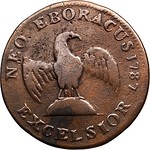
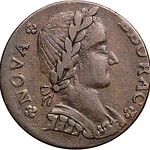
The 1787 Nova Eborac Coppers are best classified as privately issued coins of the New York area, not solely patterns or imitations of British coins. It may be true that the producers of such pieces were initially hoping for a government contract and a formal authorization by New York State. In March 1787, however, such requests were categorically denied.
 There are perhaps thirteen 1787 Clinton Copper patterns in existence. Although the Kendall piece is not
of the same quality as the piece that was in the collection of Eric Newman, it is an excellent Clinton pattern that is of much higher
quality than many other surviving coppers from the 1780s.
There are perhaps thirteen 1787 Clinton Copper patterns in existence. Although the Kendall piece is not
of the same quality as the piece that was in the collection of Eric Newman, it is an excellent Clinton pattern that is of much higher
quality than many other surviving coppers from the 1780s.
To read the complete article, see:
New
York Copper Coins and Patterns in the Kendall Collection
(www.coinweek.com/expert-columns/greg-reynolds-classic-rarities/new-york-copper-coins-and-patterns-in-the-kendall-collection/)
THE BOOK BAZARRE
BELL CANADIAN TOKEN COLLECTION OFFERED
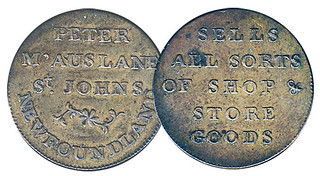 Hundreds of pieces of Canadian history are ready to be auctioned off at the 2015 Toronto Coin Expo this
spring.
Hundreds of pieces of Canadian history are ready to be auctioned off at the 2015 Toronto Coin Expo this
spring.
Held in partnership with New Brunswick’s Geoffrey Bell Auctions, the semi-annual coin show takes place May 29 and 30 at the Toronto Reference Library on Yonge Street.
Geoff Bell, auctioneer and owner of Geoffrey Bell Auctions, said he expects the sale, which includes his collection of about 400 pre-Confederation tokens, to be outstanding.
“We’re going to have my collection, which is probably the best offered in the last 20 years, and we’ve got some nice supplementary material from other collectors to go with it,” he said.
“It’s going to be a real first-class sale.”
Luckily for Bell and other Canadian numismatists, Canada’s complex social history – often divided between lines like English/French, Upper/Lower and Aboriginal/European – has left behind a remarkable variety of coins and tokens for collectors to enjoy.
“As you know, tokens are broken down into categories – there’s the pre-Confederation tokens, and then after that we’ve got local tokens, and they were issued by merchants in various communities to give away, similar to Canadian Tire money.”
Local business would often dispense these tokens in their customer’s change to entice them to shop there again soon. However, prior to Canadian Confederation, there was a lack of specie (coins made from precious metals), so businesses were left to issue their own tokens as currency.
“This will probably be the finest pre-Confederation token collection offered at least since the [Roy] Hughes collection was offered a number of years ago. Condition-wise, it’s going to be outstanding; variety-wise and in regards to the availability of rare pieces, it’s probably as good as has been offered in a long time.”
Bell has been collecting these tokens over the past five decades. “Of course, the obvious thing is, as you get more sophisticated at it, you want better-conditioned specimens plus you want the very rare specimens, and some of them are very rare.”
One of the rarities offered from his collection is a roughly 170-year-old McAuslane token (Breton 956) struck for the owner of a Newfoundland dry goods store in 1844.
“The star of the collection is the McAuslane token,” said Bell. “He was a blacksmith in St. John’s around 1844, and he ordered 100 farthing-sized tokens to use in his store.”
To read the CoinWeek article, see:
170-year-old
token ‘star of collection’ at Toronto Coin Expo
(www.coinweek.com/world-coins/canadian-coins/170-year-old-canadian-token-star-of-collection-at-toronto-coin-expo/)
To read the Canadian Coin News article, see:
170-year-old token ‘star of collection’ at
Toronto Coin Expo (http://canadiancoinnews.com/170-year-old-token-star-collection-toronto-coin-expo/)
COINS MAY BE FROM A "ROMAN MCDONALD'S"
"Worthless" Roman coins found during a dig in Lincolnshire support a theory there was a McDonald's-style eatery on the site, archaeologists believe.
About 300 coins were unearthed during a dig in Navenby in 2013, along with the remains of several Roman buildings.
It is thought the coins were dropped by people stopping off to eat while travelling between London and York.
He said due to the coins being of such low value it was likely people had discarded them while visiting the Roman equivalent of a fast-food outlet on the site.
"It wasn't a hoard, or anything like that - these were scattered about.
"It was as if people had dropped them while eating and drinking and couldn't be bothered to pick them up."
Evidence of food preparation was also found, including bones from cattle, sheep and goats.
Mr Cox said there was a lack of personal artefacts, which supported the theory the site had been used as a sort of Roman service station.
To read the complete article, see:
Roman McDonald's theory over Navenby coins find
(www.bbc.com/news/uk-england-lincolnshire-32016425)
SPINK SELLING EBORACUM HOARD COINS
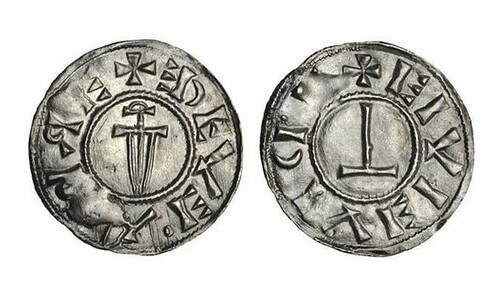
Viking penny with the Christian Cross and Thor’s hammer
TWO treasure hunters are due for a £100,000 windfall today when a unique auction of Viking and Saxon coins they found in a muddy field takes place.
Metal detectorists John Jackson and Mike Rickatson unearthed 65 coins in two batches in the field in Ryedale, North Yorkshire in 2012.
They were declared treasure and offered to the British Museum and the York Museum.
Both declined, saying the coins were overvalued and the museums had similar items in their collections.
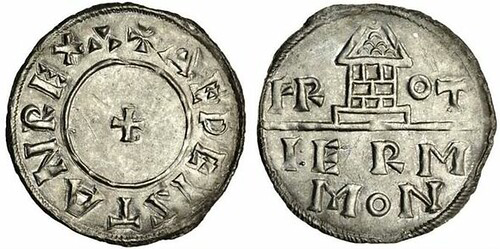
King Aethelstan penny
The coins named the Eboracum Hoard – the Roman name for York – were returned to the men who are selling them at Spink, in London.
They offer an insight into the 10th century power struggle in Northumbria.
The Viking coins date to the 920s.
The Anglo-Saxon coins mark King Aethelstan’s victory over the Vikings in 927.
To read the complete article, see:
Treasure
hunters discover 65 rare coins in muddy field expected to sell for £100,000
(www.express.co.uk/news/uk/566334/Treasure-hunters-discover-65-rare-coins-muddy-field-expected-sell-100-000)
THE MOHAWK VALLEY HOARD COINS
They were slabbed by NCS, and they state:
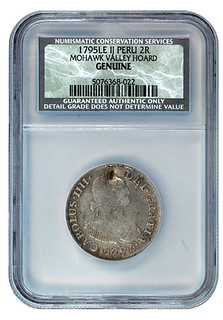 NCS has recently encapsulated the Mohawk Valley Hoard in NCS Genuine holders. This hoard was found near
Albany New York buried in the ground. The hoard had existed only in legend until it was recently discovered with the help of metal
detectors. The hoard contains bust half dollars as well as a significant number of bust quarters. Spanish Colonial pieces consisting
primarily of 2 Real coins were also discovered. While it is not known when the coins were buried, the most recent date on any coin in the
hoard is 1842. The coins were discovered in rows and may offer a glimpse into the silver coins in circulation in the first third of the
19th century.
NCS has recently encapsulated the Mohawk Valley Hoard in NCS Genuine holders. This hoard was found near
Albany New York buried in the ground. The hoard had existed only in legend until it was recently discovered with the help of metal
detectors. The hoard contains bust half dollars as well as a significant number of bust quarters. Spanish Colonial pieces consisting
primarily of 2 Real coins were also discovered. While it is not known when the coins were buried, the most recent date on any coin in the
hoard is 1842. The coins were discovered in rows and may offer a glimpse into the silver coins in circulation in the first third of the
19th century.
NCS Continues:
The coins appear to be intentionally marked by those who buried the hoard. Notches were punched into the coins either along the top edge of the coins or in the center of the coin often in front of the portrait always on the obverse of the coin. These marks, along with environmental damage to some of the pieces, would prevent the hoard from being certified by a major grading service such as NGC. It is speculated that these marks were made so that the owner would know the hoard was found should coins with such marks begin appearing in circulation.
All coins in the hoard have been encapsulated under NCS Genuine Only service. There is no mention of the grade of the details on the label. Each half dollar is fully attributed with Overton numbers according to Variety Plus standards and the quarters have been attributed according to the Browning reference. The Spanish Colonial pieces have been fully attributed according to date, mint, and assayer initials. All coins have the pedigree "Mohawk Valley Hoard" listed in the coin's description.
An example of the mark can be seen here: http://www.ncscoin.com/images/enews/0506_1_5076368-022o.jpg
The story as written can be found here: http://www.treasurenet.com/forums/treasure-news/56169-mohawk-valley-hoard-fantastic-find.html
Among the loose rocks, under just a couple of inches of soil, were STACKS of Bust Half Dollars. In all, in this one ‘hole’ were 164 Bust Half Dollars and 1 Eight Reale. Because they were stacked, and because they were in well -drained soil among loose rocks, the coins for the most part are nearly as nice as the day they were buried. Most are in grades of VF to choice AU. Again, all were hallmarked.
The searching continued daily for the next week and a half and each day at least one additional cache was found. Most coins were Bust Halves or 2 Reales. On Easter Sunday 2002, the detector went off once again, heralding the discovery of approximately 100 Bust Quarters in one spot. Looking closely at the land, it could be seen that the quarters had been buried at the base of a large tree, long since fallen and decayed back into the soil. Again, all the coins contained the hallmark, with grades ranging from VG to AU. A similar situation later in the year yielded a group of 50 2 Reales which had been buried at the base of a tree which apparently died, fell over and slid down the hillside. Some of the coins, having been tangled in the roots, were dragged down the hillside with the tree. The remainders were at what was once the tree’s base.
Overall, there have been approximately 18 different caches totaling about 550 coins—which included about 100 2 Reales and one 8 Reale. The rest were all Bust Quarters and Halves. All but two of the coins were hallmarked. While the size and quality of the coins in this find are unique in themselves, there are a number of other curious and amazing facts: No higher denominations were found. No copper was found. None of the coins was in any type of container—all were stacked among loose rocks. The US coins ranged in date from 1794 (half dollar) to 1838 (bust quarters and halves). Besides the 1794 half, a number of rarities were among the hoard. Included was one 1815/2 half (full luster AU58), condition census bust quarters including one of the finest known 1805 Browning 5s, a 1818 B9 and an XF and AU 1818 B10—perfect reverse—an extremely rare variety. One of the three non-hallmarked coins is an 1817/3 half in AU58. The two Reales range farther back into the 1700s and are generally in AG to Fine. A small group of the reales and halves exhibited, in addition to the hallmarks, recognizable countermarks from the period.
There has been a great deal of research and educated speculation regarding the well known E and L countermarks on Bust Quarters (some of which were found in the Albany, NY area). We can now add an additional mystery cache—with three different countermarks or hallmarks. The Mohawk Valley was an area of relatively heavy commerce and travel in the early 1800s. Were the coins buried treasure from river pirates? Were they hidden by a local resident who marked them in order to know if the caches had been found and spent? Were they marked to indicate they were genuine? Our search of historical documents from the Mohawk Valley has not yet yielded any clues. Curiously, no Bust Dollars were found. Perhaps there are even more coins in the farm fields, but located away from obvious landmarks! Only time will tell.
Over 200 coins from this find have been acquired by Keshequa Coins of Nunda, New York. In the interest of preserving and promoting numismatic scholarship, we have made some of these coins available to the John Reich Collector Society for census and documentation purposes.
To read the complete newsletter issue, see:
JR Newsletter: 29 March 2015 (234)
(http://jr-newsletter.blogspot.com/2015/03/jr-newsletter-29-march-2015-234.html)

WOMAN TURNS BANK BUILDING INTO HER HOME
Caitlyn Mitchell is a Senior Associate Editor at Whitman Publishing. She writes:
I just wanted to share this interesting story – I think E-Sylum readers would enjoy it. Cathy Calhoun and her 1872 bank-turned-house are the feature: Ms. Calhoun has displayed old bank paperwork, currency, coins, etc., and hopes to uncover the bank’s printing press soon. Many treasures were discovered in the old bank’s safe deposit boxes.
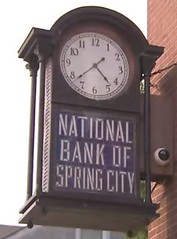 Cathy Calhoun's first job was as a bank teller at The National Bank of Spring City in
Spring City, PA. She went on to own a jewelry store, but when she saw that the old bank was for sale in 1989, she jumped at the opportunity
to buy it. She paid $52,000 for the vacant building, but it would still take 24 years of renovating to transform it into what it looks like
today. This video gives you a nice tour of her home, but below there is some additional information, provided by the CNN Money website.
Cathy Calhoun's first job was as a bank teller at The National Bank of Spring City in
Spring City, PA. She went on to own a jewelry store, but when she saw that the old bank was for sale in 1989, she jumped at the opportunity
to buy it. She paid $52,000 for the vacant building, but it would still take 24 years of renovating to transform it into what it looks like
today. This video gives you a nice tour of her home, but below there is some additional information, provided by the CNN Money website.
The 5,200 square foot building was originally built in 1872, but looked to still be in great condition at the time of the sale. Cathy left a lot of the layout the same, but with some clever changes, it is now a 3-bedroom, 3-bathroom house that even has a special room in the basement.
Though she's added a lot, the bank had its own little treasures that have become part of the decor - including the chandeliers, which are original to the building. Some of the monetary decorations were found within the abandoned safety deposit boxes. She has explored almost all of them, but there are 222 she has not been able to open since she doesn't have the keys. I hope she is able to gain access to them someday, because there is no telling what could be hidden inside.
The exterior of the building looks the same as it always has, and she even returned the clock, which can be seen in the exterior shots, to its original spot. She unveiled it when it was reinstalled and she said people cried when they saw it in its original position. The double-door entrance is the same as well, except she put "Calhoun Federal" on it in gold lettering for fun. She said people who are interested in banking there still knock on the doors from time to time, but she playfully tells them that she is only accepting deposits.
She opened up the lobby to restore it to its original 40-foot height, and also hired a painter to decorate the ceiling. The baby pink clouds in a light blue sky are meant to imitate a sunset in the Pennsylvania countryside. She chose the old boardroom as her master suite and left it mostly the same. She described it on CNN Money: "It's two stories high, has seating, a fireplace, a Jacuzzi and a big-screen TV." It sounds quite luxurious.
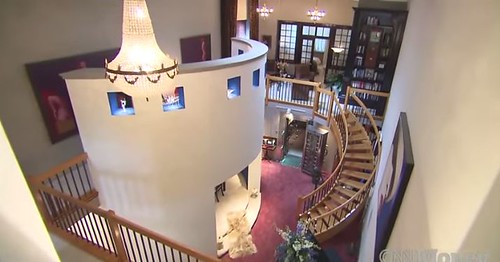
I'll let the video tell you about what she did with the vault in the basement, but there is actually something else hiding down there that isn't mentioned in the clip. The local historical society claims there is a secret room where the old bank's note-printing press is located. It is said they concreted the room closed rather than remove the press; Cathy's next project will be to uncover that room.
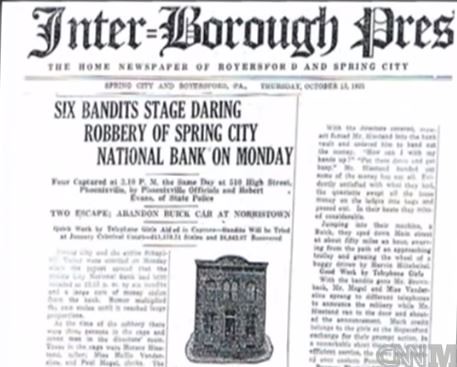
To read the complete article, see:
Woman Buys The Bank She Once
Worked At And Transforms The Inside
(http://ee.sfglobe.com/2015/03/25/woman-buys-the-bank-she-once-worked-at-and-transforms-the-inside/)
EARLY BANK ROBBERIES IN VIRGINIA
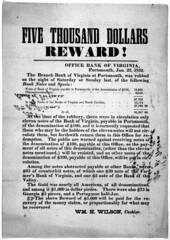 I saw your piece on that blog article about the putative "first" New York bank robbery in the
1830s and was reminded of two bank robberies in antebellum Virginia, one from 1841 and another from 1852, that folks might be interested in
hearing.
I saw your piece on that blog article about the putative "first" New York bank robbery in the
1830s and was reminded of two bank robberies in antebellum Virginia, one from 1841 and another from 1852, that folks might be interested in
hearing.
The first I came across in an original copy of the Richmond Enquirer from September 7, 1841 that I found in a flea market many years ago. In it there was a $5,000 reward notice on the front page for information regarding the theft of $92,135 from the Danville branch of the Farmer's Bank of Virginia on the 23rd of August. Apparently, someone made a false set of keys and made off with that sum all in currency. All but $20,000 was cancelled and due to be shipped back to the mother bank in Richmond for destruction, but the remainder of the loot was still current. Most interestingly, on page 3 of the same paper there is a notice indicating that the $20,000 was recovered in a graveyard and that the bank's teller was found hiding the money by the cemetery's sexton. I've included both the reward notice and the follow-up article.
In addition, the Library of Congress has in their collection a handbill announcing a $5,000 reward regarding the theft of over $66,000 from the Portsmouth branch of the Bank of Virginia in January of 1852. Included in the notice was a list of what was taken, including "$75 in Georgia $5 pieces, and a Portuguese half-Joe." I would hazard a guess that the "Georgia $5" pieces were likely Bechtler Georgia coins as those were specially singled out for notice. I have not been as successful in tracing down if this robbery was solved.
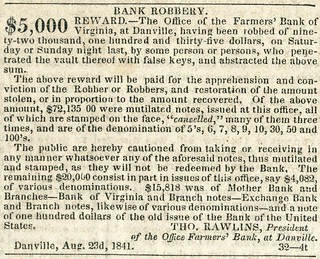
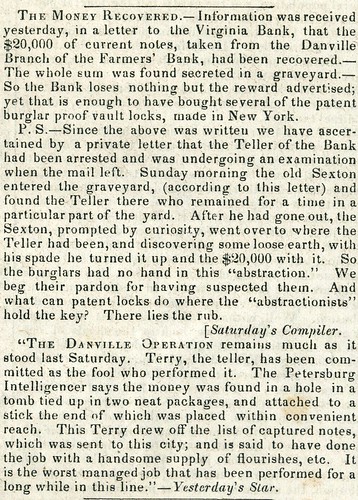
To read the earlier E-Sylum article, see:
NEW YORK'S FIRST BANK ROBBERY
(www.coinbooks.org/esylum_v18n12a32.html)
THE BOOK BAZARRE
BRITISH COMPANY GIVES AWAY FOLDED BANKNOTES
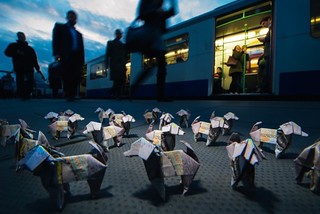 Hundreds of origami dogs made out of U.K. banknotes were randomly placed in the streets of London this
week as part of a campaign to show how the average person overpays on their life insurance.
Hundreds of origami dogs made out of U.K. banknotes were randomly placed in the streets of London this
week as part of a campaign to show how the average person overpays on their life insurance.
The stunt was carried out by online life insurance provider Beagle Street, with a team of origami experts spending hours folding five
hundred dogs out of £10 notes.
 The small paper beagles were then let loose in different locations across the capital, for passersby to
find and take away with them. The ‘Release the Pounds’ campaign was thought up by the company to demonstrate their aim to put money back
into people’s pockets.
The small paper beagles were then let loose in different locations across the capital, for passersby to
find and take away with them. The ‘Release the Pounds’ campaign was thought up by the company to demonstrate their aim to put money back
into people’s pockets.
More of the £10 origami dogs are due to be released in other cities across the U.K. in the next few weeks.
To read the complete article, see:
Banknote Origami Dogs Released onto Streets of
London (www.psfk.com/2015/03/beagle-street-origami-dogs-release-the-pounds.html)
COINS FOUND IN POSSIBLE ARGENTINA NAZI HIDEOUT
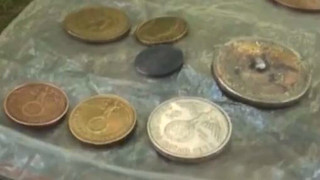 Archaeologists in Argentina believe a collection of ruins found deep in a remote jungle region
may be the remains of a secret hideout built by German Nazis to flee to after World War II, a report said Sunday
Archaeologists in Argentina believe a collection of ruins found deep in a remote jungle region
may be the remains of a secret hideout built by German Nazis to flee to after World War II, a report said Sunday
A team of archaeologists is studying the remains of three buildings located in the Teyu Cuare provincial park in northern Argentina on its border with Paraguay, the Clarin newspaper reported.
The University of Buenos Aires researchers have found five German coins minted between 1938 and 1941 and a fragment of porcelain plate bearing the inscription “Made in Germany.”
“Apparently, halfway through the Second World War, the Nazis had a secret project of building shelters for top leaders in the event of defeat — inaccessible sites, in the middle of deserts, in the mountains, on a cliff or in the middle of the jungle like this,” the archaeologists’ team leader Daniel Schavelzon told Clarin.
Ultimately, though, the hideout wasn’t needed.
Thousands of Nazis, Croatian Ustasha fascists and Italian fascists arrived in Argentina with the blessing of president Juan Peron, who led the nation from 1946 to 1955 and again briefly in the 1970s, according to the Nazi-hunting Simon Wiesenthal Center.
In 1960, Nazi Adolf Eichmann, who helped organize the Holocaust, was captured in Buenos Aires by an Israeli commando team and tried in Israel where he was executed.
Among other Nazis who sought refuge in Argentina were Josef Mengele, Martin Bormann, Walter Kutschmann, Josef Schwammberger, Eduard Roschmann, Wilfred Von Oven, and Alois Brunner.
To read the complete articles, see:
‘Argentine archaeologists explore
possible Nazi hideout’ (www.timesofisrael.com/report-argentine-archaeologists-explore-possible-nazi-hideout/)
'Nazi Hideout' in
Argentina Discovered by Archaeologists
(https://gma.yahoo.com/nazi-hideout-argentina-discovered-archaeologists-142743373--abc-news-travel.html)
Secret
Nazi hideout believed found in remote Argentine jungle
(www.washingtonpost.com/news/morning-mix/wp/2015/03/23/secret-nazi-lair-believed-found-in-remote-argentine-jungle/?hpid=z6)
A WEST COAST NUMISMATIC LIBRARY

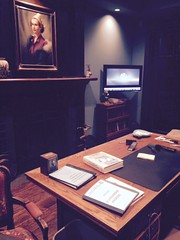
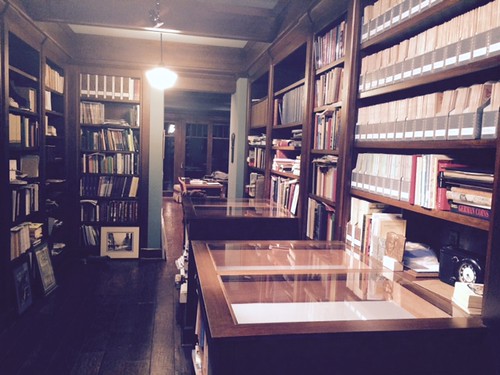
Our contributor adds:
You will see in some of the photos that I had four display cases built in. They provide for a secure way to show coins to guests. The inside dimensions are the same as the cases the ANA uses at the spring and summer shows.
To view the complete photo album, see:
A West Coast Numismatic Library
(www.flickr.com/photos/coinbooks/sets/72157649310899773/)
